October 19, 2022
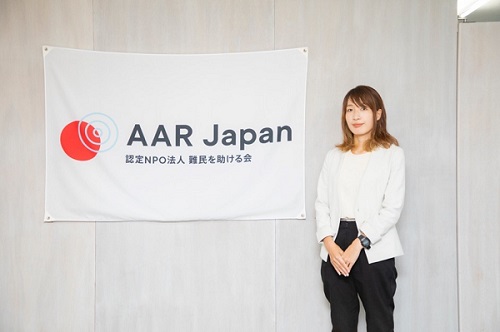
Have you ever heard of a disease called mycetoma? Mycetoma is an infectious, inflammatory disease that is most commonly found on the feet, and is endemic in tropical and subtropical regions, including the African continent. It is caused by bacteria or fungus entering the body through a cut or wound and infecting the tissue beneath the skin. Since there is a lack of basic information on the disease, including its transmission pathway and incidence, it is said to be one of the most neglected tropical diseases.
Eisai entered an agreement to support international non-governmental organization (NGO) Association for Aid and Relief, Japan’s (AAR Japan) program to combat mycetoma in 2019. What kind of initiatives does AAR Japan engage in to tackle mycetoma? We recently interviewed Tomomi Awamura of AAR Japan to learn more.
AAR Japan, an NGO currently providing assistance in 16 countries
Please tell us the history, vision and mission of AAR Japan.
AAR Japan was founded in 1979 by an ordinary Japanese woman with the aim of providing assistance to Indochinese refugees and is recognized and registered by the United Nations. Based on the traditional Japanese spirit of "Mutual aid in times of need," we provide necessary assistance to people who are facing difficulties due to conflicts, disasters, and poverty.
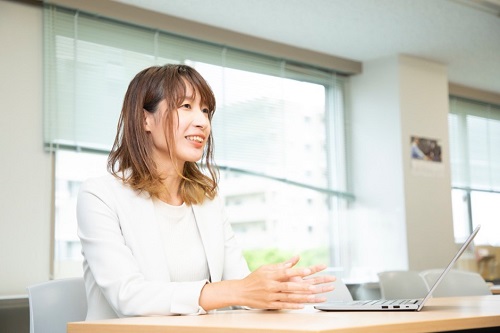
To date, AAR Japan has provided assistance in more than 60 countries and regions around the world and is currently active in 16 countries. We work in six areas including refugee assistance, mine action, disability and development, disaster relief, fighting infections/WASH, and advocacy/awareness raising.
There are approximately 50 employees in our Japan headquarters, as well as 30 expatriate staff in 10 regions, and 300 local staff. Our employees are from different countries with diverse backgrounds from those who worked in overseas sales for private companies, to system engineers for IT companies, to piano teachers.
When did you first become interested in NGO and aid activities?
I was inspired to pursue a career in aid activities for developing countries by a documentary I watched in elementary school about street children in the Philippines. I studied poverty issues in Africa at university and interned at a local NGO in Africa after graduation. Then I worked for an NGO tackling poverty issues in Africa and worked in a private company before joining AAR Japan about 10 years ago.
At AAR Japan, I worked as a headquarters staff in Tokyo for a year, and then I was stationed in Zambia for a total of two and a half years, where I was in charge of HIV/AIDS control, and maternal and neonatal health. Since 2020, I work as a general manager, overseeing the refugee assistance and infectious disease control programs of 4 African countries - Zambia, Sudan, Uganda, and Kenya.
Activities for mycetoma: Disease awareness, medical support, and training for healthcare professionals
Please tell us about the initiatives to combat mycetoma that you are involved in.
In Sudan, where many people are infected with mycetoma, our activities focus on 3 pillars - disease awareness, treatment provision and training for healthcare professionals.
Due to the slow and painless nature of the symptoms, most patients don’t seek help until the disease is already advanced. Mycetoma is little-known to local people, even to healthcare professionals. Therefore, our first step is to raise awareness of the disease and provide training to healthcare professionals to ensure that they have accurate knowledge.
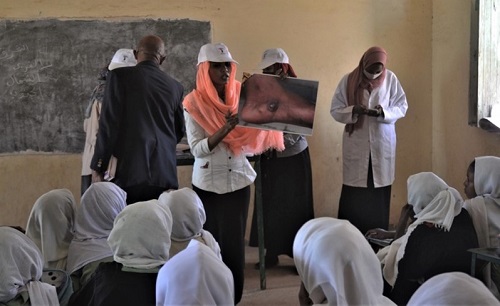
Since hospitals providing treatment for mycetoma patients are limited to the capital city of Sudan, AAR Japan is working with the Mycetoma Research Centre to dispatch medical teams to provide diagnosis and treatments for people living in remote areas.
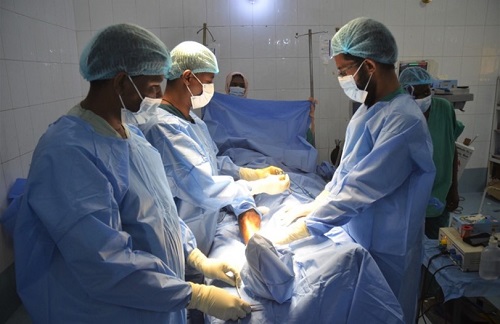
Surgery for a mycetoma patient performed at El Manaqil Hospital (El Manaqil, Sudan, July 2021)
The important thing is to make these activities rooted in local communities. Therefore, we are engaged in capacity building of local cooperative organizations and providing training sessions on how to successfully implement projects and activities. AAR Japan is also working to build up a network of potential activists including individuals and organizations that can be involved in the mycetoma program.
Please tell us how you started the activities for mycetoma.
Originally, AAR Japan was working on mine action in Sudan to protect people from landmines and unexploded ordnances as well as providing support for prosthetic limbs for landmine victims. We found that many people in Sudan had lost limbs due to mycetoma instead of landmines. Upon further research, we learned that these are people who have had their limbs amputated due to the aggravation of mycetoma.
It is believed that there are patients not only in Sudan but in Venezuela, Brazil and other countries, and the challenge is that the number of patients and their actual situation is not clear. Before AAR Japan started its activities, there were few programs for mycetoma in Sudan, so we thought that “this is a critical issue we must tackle” and were determined to start our project in 2013.
“We are not supporting people in Africa, we are working with them to tackle issues”
Have you encountered any difficulties in your activities in Africa?
One of the challenges is that events and schedules that have been set can easily be blown away. For example, during the rainy season, roads are blocked, and people cannot gather for training, online training cannot be conducted due to a sudden Internet shutdown, and even when we thought everything was settled, it can beback to square one and we have to start over.
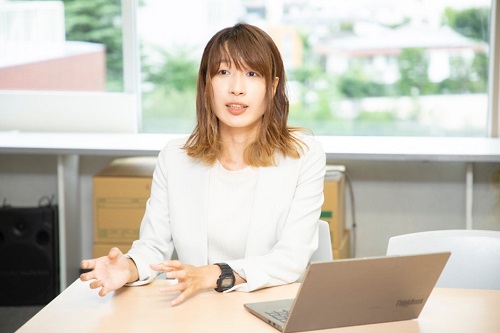 I try not to be happy or sad when I face these challenges, but to accept that " it is what it is " and work on making a recovery plan or re-adjusting schedules. However, in such case, expatriate and local staff are facing a tough time, so I always try my best to communicate with them to relieve their anxieties as much as possible.
I try not to be happy or sad when I face these challenges, but to accept that " it is what it is " and work on making a recovery plan or re-adjusting schedules. However, in such case, expatriate and local staff are facing a tough time, so I always try my best to communicate with them to relieve their anxieties as much as possible.
Did you have any happy moments in your activities in Africa?
One of the happy moments is when people who had never heard of mycetoma recognized that it is a disease, received treatment, and said, "Thank you" to us.
Not limited to mycetoma, when I witness the dedication of local people to improve their own lives or to help others, I always feel that "it’s my pleasure to be here and participate in these initiatives”. Rather than giving support directly to local people, we work with them to help them promote activities voluntarily which benefit others and improve their own lives. We have a strong sense that we are "working with local people to tackle these issues" instead of "providing support”.
Collaboration toward behavior change for local people
How are the roles divided in the collaboration between AAR Japan and Eisai?
AAR Japan has been collaborating with Eisai since 2019. Eisai provides not only financial support, but also the expertise and network to support the training for local cooperative organizations and healthcare professionals. We are currently conducting online training on mycetoma for healthcare providers in remote areas in Sudan, and the lecturer was introduced by Eisai.
At the training session, we shared Eisai’s initiatives towards the drug development for mycetoma with healthcare professionals, staff of the Mycetoma Research Centre and the Prosthetics and Orthotics Center, as well as people who have never heard of mycetoma. Meanwhile, AAR Japan is responsible for the research and outreach to local organizations and people who are willing to support our initiatives for mycetoma.
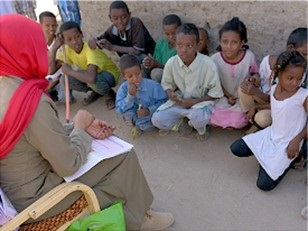
At the planning stage of the collaboration, AAR Japan and Eisai discuss activities we want to engage in, then AAR Japan proposes specific plans for the activities and we work together to promote the project. We also receive information on outside funding and discuss what we can do to further accelerate our activities with said funding.
What do you feel is the significance of the collaboration between AAR Japan and Eisai?
When we provide assistance, we are always considering what we can do to help local people change their behavior to improve their own lives. When we think about promoting behavior change for mycetoma, it’s difficult for us to tackle this challenge alone. However, in partnership with Eisai, now we are able to tell patients that “there is hope for the treatment development”. This is a big push to accelerate our activities.
In the fight against mycetoma, we have provided treatments for 90 patients and conducted disease awareness activities for 2,500 residents to date via the collaboration with Eisai. In 2022, our goal is to provide treatments to 80 patients, disease awareness activities for 500 residents and training for 50 healthcare professionals.
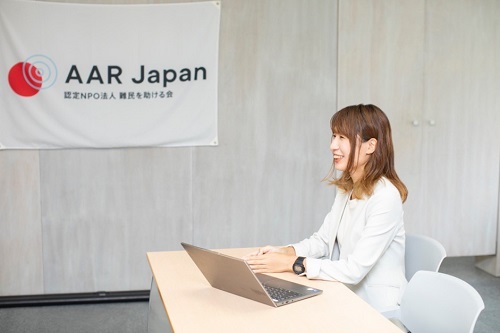
We are always grateful for the funding and donations we receive, but in many cases, the collaboration between AAR Japan and companies is part of CSR activity which is short-lived, lasting only six months or one year.
On the other hand, Eisai’s corporate concept is to “give first thought to patients and the people in the daily living domain, and increase the benefits that healthcare provides to them as well as meet their diverse healthcare needs worldwide”. This concept has so much in common with AAR Japan’s mission to “provide those the assistance they need, and make tomorrow better than today for everyone”, and the issues we want to address are the same. Remarkable outcomes can be expected through a long-term collaboration of three years. Another encouraging aspect is that we can propose collaborative project to other companies utilizing the partnership with Eisai as a model.
Please tell us what you aim to achieve in the future through the collaboration with Eisai.
We are discussing with Eisai a potential initiative for AAR Japan and Eisai to work as a hub for mycetoma programs, involving embassies and other partners to scale up our activities. In addition to mycetoma, we also received Eisai’s financial support for Ukraine and support materials for COVID-19 countermeasures. We are expecting extended collaboration with Eisai in the future.
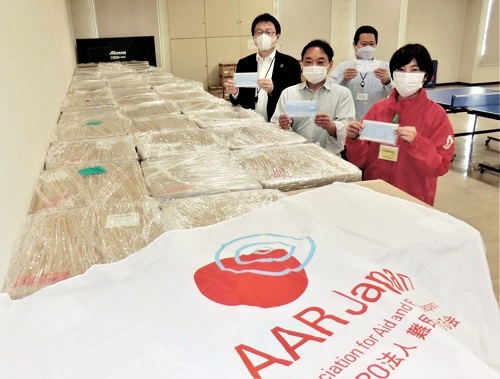
By collaborating with Eisai, a well-known company in Japan and overseas, AAR Japan hopes that people in Japan begin to take an interest in NGOs and social contribution, and understand that this is not a hurdle but something we’re all familiar with. We would be delighted if we can involve more Japanese people to work together for a better world.
Eisai's thoughts after the interview
The mycetoma program starts with making people aware of the disease
To tackle mycetoma, the first step is to make people understand what the disease is and what kind of prevention and treatment is effective. Eisai believes the progress of our initiatives is attributed to the successful cross-sectoral collaboration with AAR Japan, whose activities are deeply rooted in local communities. Eisai will continue its long-term collaboration with AAR Japan to tackle mycetoma and realize a society in which people suffering from diseases can have hope.
